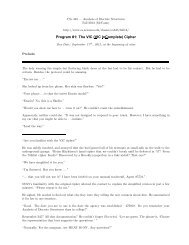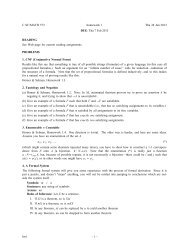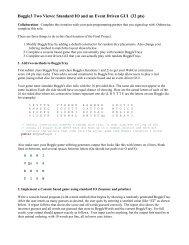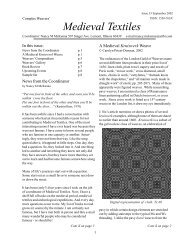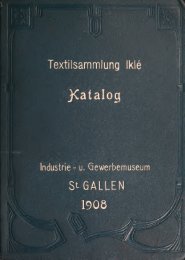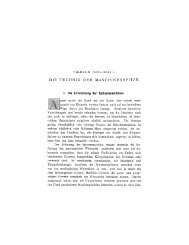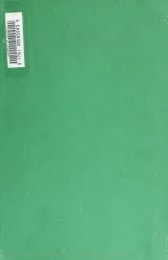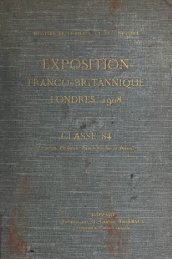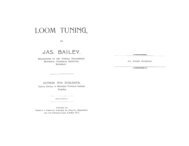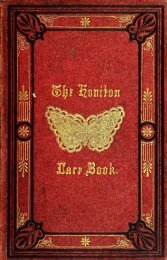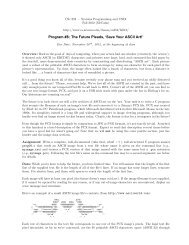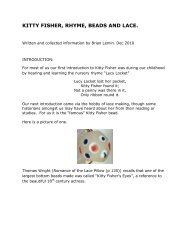The Priscilla Battenberg and point lace book; a collection of lace ...
The Priscilla Battenberg and point lace book; a collection of lace ...
The Priscilla Battenberg and point lace book; a collection of lace ...
You also want an ePaper? Increase the reach of your titles
YUMPU automatically turns print PDFs into web optimized ePapers that Google loves.
G>mbmation Stitches.<br />
Another pretty network is made by a combma-<br />
tion <strong>of</strong> Brussels net <strong>and</strong> Spanish net stitches, as<br />
shown in Fig. 94. <strong>The</strong> thread is fastened at the<br />
upper right corner <strong>of</strong> the space to be filled, <strong>and</strong> a<br />
row <strong>of</strong> Brussels net stitches worked at regular in-<br />
tervals. <strong>The</strong> thread is then fastened to the edge<br />
<strong>of</strong> the braid at the left <strong>of</strong> the space, <strong>and</strong> overcast<br />
along its edge a distance equal to the length <strong>of</strong><br />
the Spanish net stitches. Into the first loop <strong>of</strong><br />
the Brussels net stitches <strong>of</strong> the first row a single<br />
Brussels net stitch is worked. Into the second<br />
loop three Spanish net stitches are p<strong>lace</strong>d. <strong>The</strong><br />
third loop holds one Brussels net stitch, <strong>and</strong> into<br />
the fourth are worked three Spanish net stitches.<br />
This is continued to the end <strong>of</strong> the row. <strong>The</strong><br />
third row is like the first — a row <strong>of</strong> open Brussels<br />
net stitches. <strong>The</strong> first stitch is p<strong>lace</strong>d at the right<br />
<strong>of</strong> the three Spanish net stitches <strong>of</strong> the row above,<br />
<strong>and</strong> the second is p<strong>lace</strong>d in the loop at their left.<br />
In this way the trio <strong>of</strong> Spanish net stitches is<br />
considered as one stitch, <strong>and</strong> the loop between the<br />
first <strong>and</strong> second Brussels net stitch encloses them<br />
all. <strong>The</strong> next Brussels net stitch is p<strong>lace</strong>d in the<br />
next loop <strong>of</strong> the row above, <strong>and</strong> the work so con-<br />
tinued to the end <strong>of</strong> the row. <strong>The</strong> fourth row is<br />
composed like the second, <strong>of</strong> single Brussels net<br />
<strong>and</strong> trios <strong>of</strong> Spanish net alternating. <strong>The</strong> Spanish<br />
net stitches are p<strong>lace</strong>d in the loops below or under<br />
the single Brussels net stitches <strong>of</strong> the second row.<br />
This results in the Spanish net' stitches occurring<br />
in diagonal lines across the network, <strong>and</strong> is more<br />
graceful <strong>and</strong> artistic than if p<strong>lace</strong>d in lines under<br />
each other.<br />
One <strong>of</strong> the prettiest <strong>of</strong> networks is composed <strong>of</strong><br />
alternating rows <strong>of</strong> Spanish net <strong>and</strong> Brussels net<br />
stitches, as shown in Fig. 95. <strong>The</strong> thread is fas-<br />
tened at the upper left corner, <strong>and</strong> a row <strong>of</strong> single<br />
Spanish net stitches is worked at regular intervals<br />
far enough apart to admit on the loop between<br />
them five or six close Brussels net stitches. When<br />
the opposite edge <strong>of</strong> the space is reached, the thread<br />
is attached to the braid, <strong>and</strong> overcast along its edge<br />
the required distance. A group <strong>of</strong> five or six close<br />
Brussels net (or buttonhole) stitches is worked over<br />
each loop between the Spanish net stitches. <strong>The</strong>se<br />
Brussels net stitches must be evenly <strong>and</strong> closely<br />
worked <strong>and</strong> there should be enough <strong>of</strong> them to fill<br />
closely, but not crowd, the loop upon which they<br />
are worked. Each loop <strong>of</strong> the first row <strong>of</strong> stitches<br />
is filled in this way with the Brussels net stitches.<br />
38<br />
<strong>The</strong> thread, upon reaching the end <strong>of</strong> the row, is<br />
again attached to the braid <strong>and</strong> overcast along its<br />
edge the length <strong>of</strong> the Spanish net stitch. <strong>The</strong><br />
third row consists <strong>of</strong> the single Spanish net stitches<br />
p<strong>lace</strong>d on the little loop between the groups <strong>of</strong><br />
Brussels net stitches <strong>and</strong> jfcst under the stitches<br />
<strong>of</strong> the first row. <strong>The</strong> fourth row is like the second.<br />
When completed the network shows a pattern <strong>of</strong><br />
open squares, with the heavy lines <strong>of</strong> Brussels net<br />
stitches reaching in parallel lines from right to<br />
left across the space, <strong>and</strong> the lighter Spanish net<br />
stitches forming parallel lines at right angles to<br />
the Brussels net stitches.<br />
A similar but less geometrical network is made<br />
wholly <strong>of</strong> Brussels net stitches (see Fig. 96).<br />
<strong>The</strong> thread is fas-<br />
Combination Stitc hes.<br />
tened at the upper<br />
left corner <strong>and</strong> a row<br />
<strong>of</strong> open Brussels net<br />
stitches is worked at<br />
regular intervals<br />
across the space.<br />
<strong>The</strong> thread is then<br />
overcast along the<br />
edge <strong>of</strong> the braid as<br />
'<br />
usual, <strong>and</strong> a second<br />
row <strong>of</strong> open Brussels<br />
net is worked into<br />
the loops <strong>of</strong> the first,<br />
row, one stitch being<br />
p<strong>lace</strong>d in each loop.<br />
<strong>The</strong> third row is the<br />
close row. Into each<br />
loop <strong>of</strong> the second<br />
row is worked five or<br />
six close Brussels<br />
net, or buttonhole,<br />
stitches. <strong>The</strong>re<br />
should always be<br />
the same number <strong>of</strong><br />
these stitches in each<br />
loop, <strong>and</strong> there should be enough <strong>of</strong> them worked<br />
closely together to nearly fill the loop. A row <strong>of</strong><br />
open Brussels net stitches is next worked, one<br />
stitch being p<strong>lace</strong>d on each loop between the groups<br />
<strong>of</strong> close buttonhole stitches <strong>of</strong> the third row. <strong>The</strong><br />
next, or fifth row, is like the second, <strong>and</strong> the sixth<br />
row is like the third.<br />
An exceedingly delicate <strong>and</strong> attractive stitch is<br />
shown in Fig. 97. <strong>The</strong> thread is, attached to the<br />
upper right corner <strong>of</strong> the space, <strong>and</strong> three rows <strong>of</strong>



